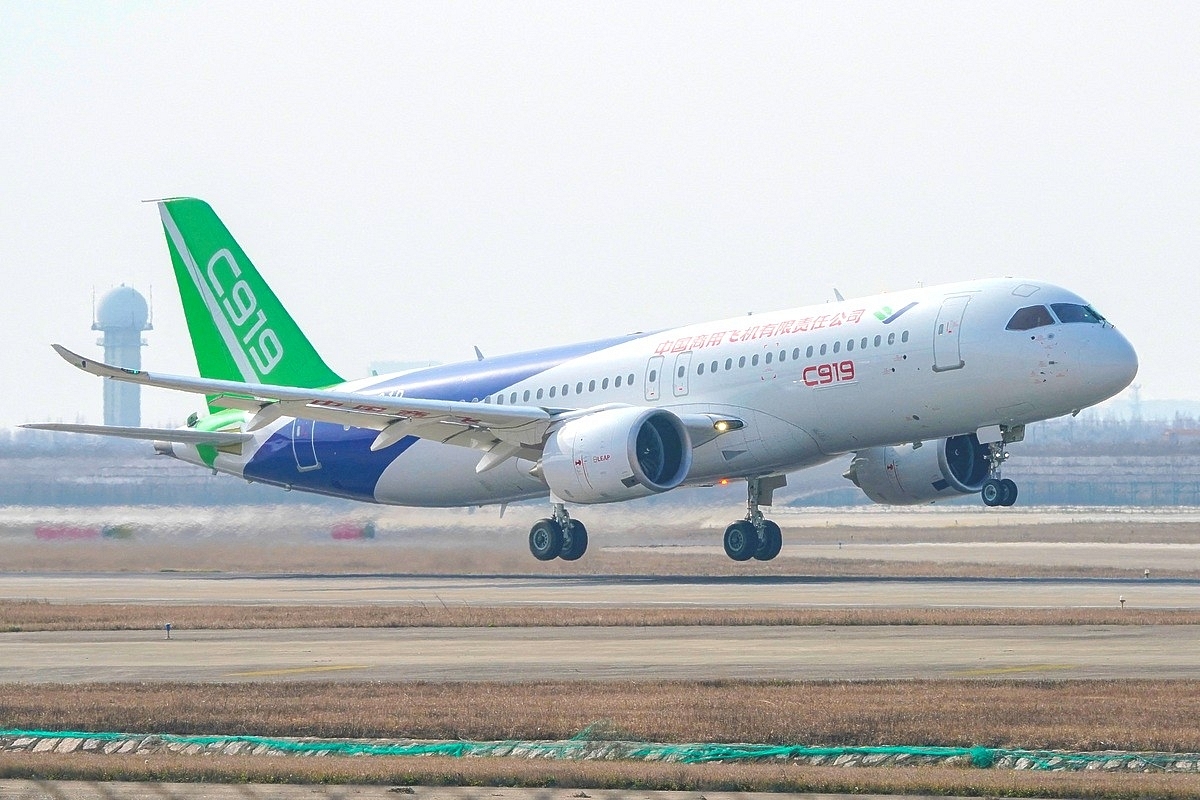Technology
China's First Domestically Built Passenger Jet Makes Maiden Commercial Flight. But How 'Made In China' Is It Really?
- In the realm of Chinese aviation manufacturing, the C919 stands as a remarkable feat, yet its flight remains tethered to the embrace of Western suppliers.

Chinese C-919 Commercial Jet (Via Wikipedia)
In a historic achievement for the Chinese aviation industry, the country's first domestically developed narrow-body passenger jet — the C-919 — completed its maiden commercial flight from Beijing to Shanghai on Sunday (28 May).
In 2007, the Politburo Standing Committee, the highest policymaking body of the Chinese Communist Party, granted official approval to the C919 as a national project. The plan made its first flight in 2017.
The aircraft has been manufactured by state-owned Commercial Aviation Corporation of China and has been built to compete against Boeing 737 Max and Airbus A-320 passenger jets in the commercial aviation market.
The Chinese media has been abuzz with excitement, heralding this significant milestone as a symbol of China's growing prowess in the global aerospace industry. However, amidst the jubilation, it is crucial to examine the extent to which the C-919 truly embodies the "Made-in-China" concept.
Some of the most critical parts of the plane that flew on 28 May came from companies based in the United States and Europe.
The most important and difficult to build part of a commercial jet is its engine. The C-919 uses CFM Leap-1A jet engines made in France. It is built by a joint venture between French engine-makers Safran and GE Aerospace, a subsidiary of the US-based General Electric. The CFM Leap-1A also powers Boeing's 737max and Airbus A-320 Neo aircraft.
The flight control system, another critical equipment that interprets pilots' inputs and moves aircraft's flight controls and fuel control system, is made by Parker Aerospace of the United States.
"A total of more than 60 types of components make up Parker’s systems and subsystems on the C919," the company revealed in 2017.
Similarly, the electrical systems and landing gear of the Chinese jet are made by Honeywell, another US-based company.
Tires, cockpit and simulation systems are made by Michelin, Eaton and Rockwell Collins, all of which are based in the US.
According to a report in Nikkei Asia, "roughly 40 per cent" of the plane's core components come from western suppliers.
The critical parts of the plane built in China include the outer hull (airframe) and flight control surfaces and cabin equipment.
COMAC, the maker of C919, has been working to replace some of the foreign parts, including an alternative for the US-French engine that currently powers the narrow-body passenger jet.
While China has made significant strides in the development of aviation technology, it has also relied on espionage to boost its efforts.
According to various experts, the Chinese have stolen designs of various other critical components from western companies.
For instance, in November 2022, a US court announced a 20-year-long jail term for a Chinese national who stole engine fan blade designs from US engine-maker General Electric.
The engine fan blades are the most critical part of a jet engine. These fan blades are designed to face extreme temperatures and pressure.
Only three countries in the world, the US, UK, and France, and to some extent Russia, have mastered this technology.
Chinese nationals have been involved in multiple cases of intellectual property theft in the United States, while state-sponsored Chinese hackers are notorious for persistently targeting Western technology.
In 2016, Chinese hackers stole designs for Pratt and Whitney's F-135 engines, which power the US' fifth-generation F-35 fighter jet.
Despite cyber theft and espionage activities, aviation technology remains a vulnerability for China, which the US can strategically leverage.
The aviation sector, an advanced technology industry, has experienced adverse consequences due to the deteriorating relations between China and the United States. Subsidiaries of the Aviation Industry Corporation of China, a shareholder in COMAC, have been included in the US Commerce Department's list of Chinese companies accused of having ties with the People's Liberation Army. This means that, in some cases, US-based companies can't deal with these entities.
Moreover, the Trump administration released a list of Military end-user (MEU) export list, which prohibits technology imports to countries that represent a risk to US national security. Many of the components that make Chinese commercial jets fly were on this list.
In the realm of Chinese aviation manufacturing, the C919 stands as a remarkable feat, yet its flight remains tethered to the embrace of Western suppliers.
Support Swarajya's 50 Ground Reports Project & Sponsor A Story
Every general election Swarajya does a 50 ground reports project.
Aimed only at serious readers and those who appreciate the nuances of political undercurrents, the project provides a sense of India's electoral landscape. As you know, these reports are produced after considerable investment of travel, time and effort on the ground.
This time too we've kicked off the project in style and have covered over 30 constituencies already. If you're someone who appreciates such work and have enjoyed our coverage please consider sponsoring a ground report for just Rs 2999 to Rs 19,999 - it goes a long way in helping us produce more quality reportage.
You can also back this project by becoming a subscriber for as little as Rs 999 - so do click on this links and choose a plan that suits you and back us.
Click below to contribute.
Latest